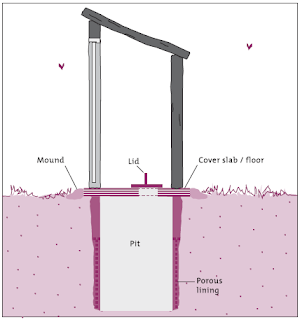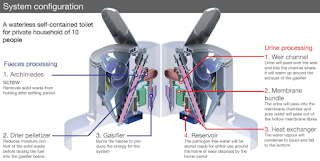THE PIT LATRINE
The default sanitation option implemented in African slums is usually the standard pit latrine, which consists of an unlined pit and basic superstructure, and can be quickly built with relatively cheap resources. In this post, the main features of the pit latrine are presented, as well as an insight into its main advantages and disadvantages.
Structure
Pit latrines consist of a single pit covered with a drop hole, and a superstructure providing shelter and privacy. Some technical features are (WHO):
- The slab may be made of wood or reinforced concrete.
- The pits can be square, rectangular or circular; and usually 1.0-1.5 m wide.
- The depth is usually 3-5, although this depends on the soil and groundwater conditions. In the cases of both unstable soil and when the pit has to be emptied, a lining is required.
- Pits sould be, by rule, at least 15-30 m from sources of drinking water, although this also varies depending on soil and groundwater characteristics.
Figure 1. Illustration showing the main components of a traditional pit latrine (WHO).
Some of the advantages of the pit latrine (OpenLearn) are:
- They do not require water, which makes them adequate in areas where the supply is inadequate.
- The practice of squatting is normal for many people, which favors acceptance.
- Alternating pits allows excreta to drain and degrade, and transform into a nutrient for soils.
- They can be constructed with local materials and skills, which makes them cheaper. This is better undestood when looking at the components of construction costs: 50-80% are linked to materials, 0-25% to transportation and 15-35% to local labour. The cost may vary as a function of factors such as the pit volume; the quality of the pit lining; the slab and the superstructure; and the availability of materials (WHO).
However, the pit latrine has lately been found to not be the most appropriate solution in many cases -especially in contexts of flood risk, high water table, low infiltration rates, rocky grounds or collapsing soils (Reade A., 2016).
Its main drawbacks and negative factors related are:
- Difficult construction in case of lack of space (Tull K., 2017).
- Need for male to use urinals are main drawbacks when it comes to build new pit latrines (Tull K., 2017).
- They are major causes of groundwater pollution, mainly because the liquid phase often infiltrates into groundwater, and the excreta collection chamber overflows during the rainy season (Katukiza et al., 2012).
- Failure to line the pit latrines, usually as a result of lack of funds and technical knowledge, causes them to collapse and therefore the need for reconstruction (Grimason et al., 2000).
- High filling rate (Katukiza et al., 2012): as the quantity of users is high, and in many cases the resources needed for emptying it are limited, the digging of extra pits is a common, and usually uncontrolled, practice.
- Sometimes landlords are unreliable (Katukiza et al., 2012). In other cases pit latrines are main sites for illegal activities such as pick-pocketing or occupation practices (Water and Sanitation Program, World Bank)
- Reluctance of municipal councils to invest in settlements which lack legal status (Katukiza et al., 2012).
- Low affordability of vacuum tanker services, and limited physical accesibility of those and other vehicles to the sanitation facilities (Grimason et al., 2000; Katukiza et al., 2012).



Comments
Post a Comment
Let me know what you think about this!